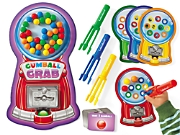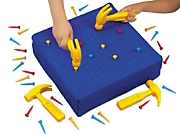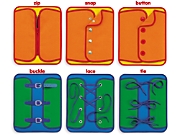Phonological Awareness is a broad term that has to do with understanding all the components of spoken language. This includes: word awareness, syllable awareness, onset-rime, rhyme awareness, and phonemic awareness. Phonological Awareness is not the same as phonics but rather the foundation for and precursor to phonics which is the understanding of how printed letters or words are related to the sounds. Phonological Awareness focuses on the sounds apart form the alphabetic code used in written language.
Word Awareness is the knowledge that spoken words are individual entities that have meaning behind them. For instance, a child knows that the spoken word “cat” represents a small animal that has four legs, a tail, and meows. It is important that children can discriminate spoken words and their meanings before reading written words.
Rhyme Awareness is the understanding that some word endings sound the same. Rhyme typically refers to the sound of the word starting with the first vowel. Children should be able to recognize through sound, words that end similarly such as “map” and “cap” or “fraction” and “traction”. It is not necessary for words to share the exact same letter pattern to create rhyme. For example, “bright” and “kite”. In the English language, many sounds are represented in more than one way.
Syllable Awareness is the recognition that words are divided into parts or recognizable chunks. Each part or syllable contains at least one vowel. We practice listening for syllables in our classroom by clapping out the sounds to hear the “beats” in a word.
The “onset” in Onset-Rime refers to the part of a word before the first vowel. The “rime” refers to the vowel and all the sounds that come after it. For instance, in the word “brick” the onset is “br” and the rime is “ick.” We create word families by using the same rime and changing the onset: brick, kick, pick, stick.
Phonemic Awareness is the most complex component of phonological awareness and refers to the smallest units of sound in a word. Phonemic awareness also refers to the ability to manipulate sounds. This includes: addition/deletion/substitution of sounds, isolation, blending and segmenting. As we approach reading in kindergarten, regular practice with phonemic awareness helps to lay a strong literacy foundation. Children practice sounding out words and hearing each individual sounds. For example, the children will break apart the word “dog” and stretch it out into the individual phonemes /d/ /o/ /g/ as they discover the word has three individual sounds. To manipulate these sounds, the child might be asked to substitute “d” for “l” and say the new word, which would be “log.” Phonemic awareness involves a lot of practice hearing and recognizing the smallest parts of a word and is a good indicator of future reading success. Young children often confuse syllables and phonemes, this is very common as they begin to listen with greater distinctions to the sounds that make up our language.
Once children become proficient with distinguishing sounds and word parts, they are ready to add the alphabetic code used to represents these sounds and governed by phonetic rules,. This is what we call phonics. Phonics is all the individual letters and combinations of letters that represent the many different sounds in our language. Phonics is also an understanding of the rules that govern how these sounds work together in written language.
All the components of phonological awareness are important to the process of reading development. The ability to hear these sounds in spoken language have a significant impact on how children will connect to reading print. Without phonological awareness, phonics (working with sounds and printed letters) will not make sense. Phonological awareness helps children to understand the relevance of printed language to spoken language. If a child has difficulty with phonological skills including phonemic awareness, they will have difficulty making the connection between and print and sound.
"The best predictor of reading difficulty in kindergarten or first grade is the inability to segment words and syllables into constituent sound units (phonemic awareness)" (Lyon, 1995)
Want to see how your child is doing with their phonemic awareness? Click here: http://righttrackreading.com/phonemicevaluation.html
Although I am an advocate for phonological awareness instruction, it does not ensure reading success for every child. Some children do very well with these skills yet have other difficulties with reading due to other underlying factors. Reading is a complex learning process and there are many pieces that go into reading success. Louisa Moats, one of our nation’s leading experts in reading is regularly quoted as saying, “Reading IS Rocket Science!”. It is not a natural instinct that we were born with but rather a complex and remarkable skill that we learn. A solid understanding and grasp of phonological awareness and other early literacy skills are our best insurance policy when it comes to reading success!






















